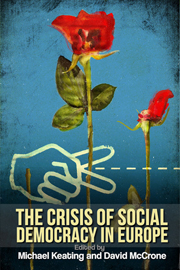Book contents
- Frontmatter
- Contents
- List of tables and figures
- About the contributors
- Preface
- 1 The crisis of social democracy
- 2 The Long Depression, the Great Crash and socialism in Western Europe
- 3 Social democracy in crisis: outlining the trends in Western Europe
- 4 The positions and fortunes of social democratic parties in East Central Europe
- 5 Rethinking public expenditure from a social democratic perspective
- 6 Social democracy in crisis? What crisis?
- 7 Can the Swedish social model survive the decline of the social democrats?
- 8 Multiculturalism, right-wing populism and the crisis of social democracy
- 9 Labour markets, welfare states and the dilemmas of European social democracy
- 10 Class politics and the social investment welfare state
- 11 Labour, skills and education in modern socio-economic development: can there be a social democratic economic and industrial policy in a globalised economy?
- 12 From single market to social market economy: is there room for solidarity?
- 13 Social democracy and security
- 14 Multilevel social democracy: centralisation and decentralisation
- 15 Conclusion
- Bibliography
- Index
7 - Can the Swedish social model survive the decline of the social democrats?
Published online by Cambridge University Press: 05 October 2013
- Frontmatter
- Contents
- List of tables and figures
- About the contributors
- Preface
- 1 The crisis of social democracy
- 2 The Long Depression, the Great Crash and socialism in Western Europe
- 3 Social democracy in crisis: outlining the trends in Western Europe
- 4 The positions and fortunes of social democratic parties in East Central Europe
- 5 Rethinking public expenditure from a social democratic perspective
- 6 Social democracy in crisis? What crisis?
- 7 Can the Swedish social model survive the decline of the social democrats?
- 8 Multiculturalism, right-wing populism and the crisis of social democracy
- 9 Labour markets, welfare states and the dilemmas of European social democracy
- 10 Class politics and the social investment welfare state
- 11 Labour, skills and education in modern socio-economic development: can there be a social democratic economic and industrial policy in a globalised economy?
- 12 From single market to social market economy: is there room for solidarity?
- 13 Social democracy and security
- 14 Multilevel social democracy: centralisation and decentralisation
- 15 Conclusion
- Bibliography
- Index
Summary
Introduction
This chapter begins with a contention dating back more than twenty years (see Milner 1989): in Sweden, social democracy is not merely the programme of a party, but constitutes a way of life incorporated into the institutions of society. Despite some overreaching in the 1970s, and the ensuing backlash in the early 1980s, the social democratic way of life had become entrenched in what had come to be known as the ‘Swedish model’. The model consisted of a logically coherent set of policies and institutions instituted over half a century by the Swedish Social Democratic Party (SAP) and its allies in and beyond the labour movement. The model withstood the wide-reaching challenges to the welfare state identified with globalisation, the neo-conservative policies of Reagan and Thatcher and the public choice ideas underlying them (Milner 1994). Adaptations to these challenges, not only in Sweden but also in Finland, Norway and Denmark, did not undermine the fundamentals of the model. Indeed, the policy choices effectively defied the stark logic of public choice: supporting the welfare state constituted a rational choice for Scandinavians.
While, as we shall see, it was never only a matter of having social democrats in power, the predominance of the SAP during this period was an enduring and seemingly eternal part of the Swedish landscape. This is no longer the case. In the last decade a significant change has taken place in Sweden, the cradle of twentieth-century social democracy, with possible repercussions elsewhere in Scandinavia and beyond.
- Type
- Chapter
- Information
- The Crisis of Social Democracy in Europe , pp. 107 - 124Publisher: Edinburgh University PressPrint publication year: 2013



